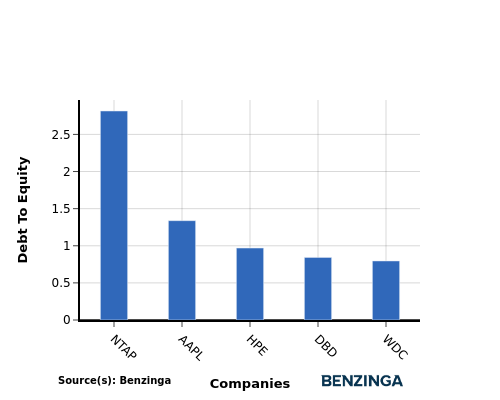Understanding Apple's Position In Technology Hardware, Storage & Peripherals Industry Compared To Competitors
Author: Benzinga Insights | November 13, 2025 10:00am
In the ever-changing and fiercely competitive business landscape, conducting thorough company analysis is crucial for investors and industry experts. In this article, we will undertake a comprehensive industry comparison, evaluating Apple (NASDAQ:AAPL) and its primary competitors in the Technology Hardware, Storage & Peripherals industry. By closely examining key financial metrics, market position, and growth prospects, our aim is to provide valuable insights for investors and shed light on company's performance within the industry.
Apple Background
Apple is among the largest companies in the world, with a broad portfolio of hardware and software products targeted at consumers and businesses. Apple's iPhone makes up a majority of the firm sales, and Apple's other products like Mac, iPad, and Watch are designed around the iPhone as the focal point of an expansive software ecosystem. Apple has progressively worked to add new applications, like streaming video, subscription bundles, and augmented reality. The firm designs its own software and semiconductors while working with subcontractors like Foxconn and TSMC to build its products and chips. Slightly less than half of Apple's sales come directly through its flagship stores, with a majority of sales coming indirectly through partnerships and distribution.
| Company |
P/E |
P/B |
P/S |
ROE |
EBITDA (in billions) |
Gross Profit (in billions) |
Revenue Growth |
| Apple Inc |
36.66 |
54.80 |
9.86 |
39.36% |
$35.55 |
$48.34 |
7.94% |
| Western Digital Corp |
23.40 |
9.65 |
5.97 |
20.57% |
$1.48 |
$1.23 |
27.4% |
| Hewlett Packard Enterprise Co |
27.62 |
1.27 |
0.95 |
1.14% |
$1.11 |
$2.67 |
18.5% |
| Pure Storage Inc |
216.07 |
22.08 |
9.01 |
3.68% |
$0.09 |
$0.6 |
12.73% |
| Super Micro Computer Inc |
29.85 |
3.47 |
1.14 |
2.62% |
$0.25 |
$0.47 |
-15.49% |
| NetApp Inc |
19.75 |
22.84 |
3.50 |
23.13% |
$0.38 |
$1.1 |
1.17% |
| Logitech International SA |
27.53 |
8.54 |
3.88 |
7.99% |
$0.22 |
$0.51 |
6.27% |
| Diebold Nixdorf Inc |
48.28 |
2.11 |
0.66 |
3.73% |
$0.11 |
$0.25 |
1.95% |
| Average |
56.07 |
9.99 |
3.59 |
8.98% |
$0.52 |
$0.98 |
7.5% |
When analyzing Apple, the following trends become evident:
-
With a Price to Earnings ratio of 36.66, which is 0.65x less than the industry average, the stock shows potential for growth at a reasonable price, making it an interesting consideration for market participants.
-
The elevated Price to Book ratio of 54.8 relative to the industry average by 5.49x suggests company might be overvalued based on its book value.
-
With a relatively high Price to Sales ratio of 9.86, which is 2.75x the industry average, the stock might be considered overvalued based on sales performance.
-
The company has a higher Return on Equity (ROE) of 39.36%, which is 30.38% above the industry average. This suggests efficient use of equity to generate profits and demonstrates profitability and growth potential.
-
Compared to its industry, the company has higher Earnings Before Interest, Taxes, Depreciation, and Amortization (EBITDA) of $35.55 Billion, which is 68.37x above the industry average, indicating stronger profitability and robust cash flow generation.
-
The gross profit of $48.34 Billion is 49.33x above that of its industry, highlighting stronger profitability and higher earnings from its core operations.
-
The company's revenue growth of 7.94% is notably higher compared to the industry average of 7.5%, showcasing exceptional sales performance and strong demand for its products or services.
Debt To Equity Ratio

The debt-to-equity (D/E) ratio helps evaluate the capital structure and financial leverage of a company.
Considering the debt-to-equity ratio in industry comparisons allows for a concise evaluation of a company's financial health and risk profile, aiding in informed decision-making.
When assessing Apple against its top 4 peers using the Debt-to-Equity ratio, the following comparisons can be made:
-
In the context of the debt-to-equity ratio, Apple holds a middle position among its top 4 peers.
-
This indicates a moderate level of debt relative to its equity with a debt-to-equity ratio of 1.34, which implies a relatively balanced financial structure with a reasonable debt-equity mix.
Key Takeaways
For Apple in the Technology Hardware, Storage & Peripherals industry, the PE, PB, and PS ratios indicate that the stock is relatively undervalued compared to its peers. However, the high ROE, EBITDA, gross profit, and revenue growth suggest that Apple is performing exceptionally well in terms of profitability and operational efficiency within the industry sector.
This article was generated by Benzinga's automated content engine and reviewed by an editor.
Posted In: AAPL






